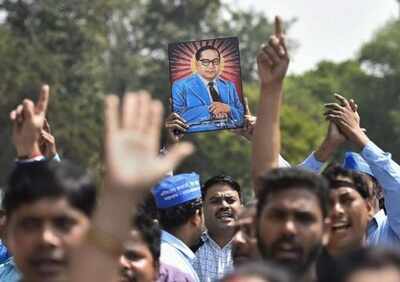
NEW DELHI: The five-judge Supreme Court order upholding states' right to undertake sub-categorisation of SCs /STs is significant because it would now stand as a neutralising counterweight to the earlier 2004 EV Chinnaiah judgement that declared it as unconstitutional. The fresh examination by the larger bench would thus start on an even keel, which opens up the issue that was viewed as virtually settled, a boost for the group lobbying for it.
What it means is that division of Dalits could be closer than before. The way Thursday’s judgement has argued the issue also raises the possibility of further strengthening introduction of “creamy layer” among SCs and STs. Recent court orders have upheld the still-to-be-implemented “creamy layer” among Dalits but it remains controversial and has been appealed against.
The looming possibility of sub-categorisation of Dalits coupled with the concept of “creamy layer” has been the biggest bugbear of rights activists who believe these concepts will sow divisions in this social bloc and loosen their political consolidation – the biggest story of recent decades – exemplified by the emergence of BSP in UP and minor outfits in southern states, as well as a pan-India Dalit civil society.
Sub-categorisation means division of SCs into sub-groups and apportioning of reservation quota among them based on their population. The idea is devised to address the complaint that some affluent sub-castes are cornering quota benefits at the cost of weaker ones.
However, the judicial pronouncements are not passing muster with all. “Today’s judgement as also recent orders have treated the SC and ST issues very casually. They have repeatedly made generalised claims about inequitable distribution of reservation benefits without any empirical data. There have also been serious inconsistencies between different orders,” remarked Anurag Bhaskar, a law faculty and expert on reservation laws.
Legalities apart, the crucial dimension of sub-classification is political. It is argued that the march of social justice has been possible because of the rallying of erstwhile untouchables as a homogenous group. The issue of benefits pits sub-groups against one another while that of emancipation and safety unites them.
Sub-categorisation gives primacy to benefits, which would turn sub-castes into competitive blocs, thereby loosening their mobilisation as a social constituency. It may in the long run dismantle Dalit politics at the national and even state level.
Community intelligentsia concedes the dilemma that the need for equitable sharing of quota benefits cannot be ignored but the solution offered may hurt the fight for social justice. “Social stigmatisation hurts as much one sub-group as it does another. But a rallying cry will not be possible once their interests are entrenched as mutually exclusive,” it is argued.
What it means is that division of Dalits could be closer than before. The way Thursday’s judgement has argued the issue also raises the possibility of further strengthening introduction of “creamy layer” among SCs and STs. Recent court orders have upheld the still-to-be-implemented “creamy layer” among Dalits but it remains controversial and has been appealed against.
The looming possibility of sub-categorisation of Dalits coupled with the concept of “creamy layer” has been the biggest bugbear of rights activists who believe these concepts will sow divisions in this social bloc and loosen their political consolidation – the biggest story of recent decades – exemplified by the emergence of BSP in UP and minor outfits in southern states, as well as a pan-India Dalit civil society.
Sub-categorisation means division of SCs into sub-groups and apportioning of reservation quota among them based on their population. The idea is devised to address the complaint that some affluent sub-castes are cornering quota benefits at the cost of weaker ones.
However, the judicial pronouncements are not passing muster with all. “Today’s judgement as also recent orders have treated the SC and ST issues very casually. They have repeatedly made generalised claims about inequitable distribution of reservation benefits without any empirical data. There have also been serious inconsistencies between different orders,” remarked Anurag Bhaskar, a law faculty and expert on reservation laws.
Legalities apart, the crucial dimension of sub-classification is political. It is argued that the march of social justice has been possible because of the rallying of erstwhile untouchables as a homogenous group. The issue of benefits pits sub-groups against one another while that of emancipation and safety unites them.
Sub-categorisation gives primacy to benefits, which would turn sub-castes into competitive blocs, thereby loosening their mobilisation as a social constituency. It may in the long run dismantle Dalit politics at the national and even state level.
Community intelligentsia concedes the dilemma that the need for equitable sharing of quota benefits cannot be ignored but the solution offered may hurt the fight for social justice. “Social stigmatisation hurts as much one sub-group as it does another. But a rallying cry will not be possible once their interests are entrenched as mutually exclusive,” it is argued.
Download
The Times of India News App for Latest India News

Coronavirus outbreak
Trending Topics
LATEST VIDEOS
India
 Covid-19 in India: Recovery rate crosses 76% mark
Covid-19 in India: Recovery rate crosses 76% mark  Jharkhand CM Hemant Soren meets trainee IPS officers in Ranchi
Jharkhand CM Hemant Soren meets trainee IPS officers in Ranchi  Police issues alert in view of heavy rainfall in J&K’s Reasi
Police issues alert in view of heavy rainfall in J&K’s Reasi  India’s unified Air Defence Command (ADC) to begin operation by October
India’s unified Air Defence Command (ADC) to begin operation by October  India shared enough evidence on Pulwama attack. but Pakistan continues to evade responsibility: MEA
India shared enough evidence on Pulwama attack. but Pakistan continues to evade responsibility: MEA  Pak has never taken any credible action against most wanted ones: MEA on Dawood Ibrahim’s whereabouts
Pak has never taken any credible action against most wanted ones: MEA on Dawood Ibrahim’s whereabouts
More from TOI
Navbharat Times
Featured Today in Travel
Quick Links
Coronavirus in MumbaiCoronavirus in KolkataCoronavirus in HyderabadCoronavirus in DelhiCoronavirus in BangaloreCoronavirus symptomsCoronavirus in IndiaWhat is CoronavirusCoronavirus NewsSolar EclipseNPRWhat is NRCCAB BillCAB and NRCRTI BillPodcast newsLok SabhaShiv SenaYSRCPCongressBJP newsUIDAIIndian ArmyISRO newsSupreme Court
Get the app



